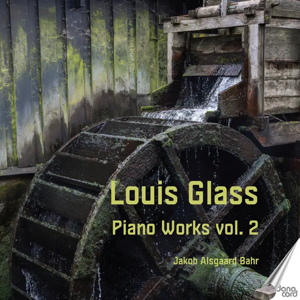
Louis Glass (1864-1936)
Piano Works Volume 2
Piano Sonata No.1 in E major, op.6 (1890)
Skitser, op.21 (?1894)
Landlige Billeder, op.48 (1915)
Sommerminder (Lyse Nætter), op.53, No.2 (c.1927)
Mazurka, op.53, No.3 (c.1927)
Aquareller, op.58 (1921)
Vort Bal (1896)
Jakob Alsgaard Bahr (piano)
rec. 2023, Festsalen, Hjørring Gymnasium, Denmark
Danacord DACOCD981 [76]
Louis Christian August Glass was born in Copenhagen on 23 March 1864. After study with Niels W. Gade, he moved to the Brussels Conservatory. He fell in love with the music of César Franck and Anton Bruckner, who both influenced him. Much of his vocation was spent as a concert pianist and cellist. His solo career ended when he developed partial paralysis, and he devoted his life to composition. He died on 22 January 1936.
Glass’s catalogue includes six symphonies, much chamber music, and many works for the piano, including three sonatas. His style was largely Romantic or late Romantic, but his aesthetic developed little. His music fell out of fashion in the early 20th century. His liking for Franck and Bruckner does not seem to carry into the piano repertoire. One will more often be reminded of Mendelssohn and Schumann. (He was a contemporary of Carl Nielsen, who also studied with Gade, but there is little comparison between the two men’s achievement.) The recent decades saw several “revivals” of Glass’s music.
The major item here is the Piano Sonata No.1. According to the liner notes, it was received with considerable acclaim. One contemporary reviewer suggested that it “is a truly magnificent work, arguably among the most significant ones written in recent years within this genre”. The booklet suggests that the sonata is well-formed and uses internal self-referencing of motifs and themes.
I listened to the sonata twice. On the first hearing, I found it a bit turgid in places, especially in the Adagio. Even the Scherzo seemed to get bogged down a touch. When I listened again, it began to reveal felicitous moments. Whether it will take its place in pianists’ repertoire is doubtful. It seems to fall in the gap between Liszt and Brahms and the later Rachmaninov and Scriabin. At best, it is a delightful piece that mostly maintains the listener’s interest.
The Skitser (Sketches) are inspired miniatures, concise, with lots of attractive pianism and fetching ideas. I think that they ought to be heard as a group of nine, rather than excerpted. My grasp of Danish does not extend to an understanding of each designation; they appear to be suggestions for performance rather than imaginative titles.
On the other hand, the Landlige Billeder (Rural Images) do include imagery to inform the listener, for example At the Village Blacksmith, In Grandfather’s Garden and Ducks on the Way to the Pond. Despite the innocent titles, I do not think that these are designed for children. There is much to suggest that Glass had noticed certain developments in contemporary European music. Certainly, there is more (very mild) dissonance in these pages, but nothing to frighten the ducks! The notes correctly describe the set as a “remarkable collection of very different movements showing an unusual side of Glass, which is a more humorous one, as well as a more daring side”.
The Aquareller are even more advanced stylistically. Once again, they are character pieces. The Watermill features a perpetuum mobile, whilst The Balladeer presents interesting “tonal possibilities”. The Shepherdess, a pleasing little “valse triste”, is a characterisation of Hans Christian Andersen’s fairy tale, The Shepherdess and the Chimney Sweep. The Dialogue and Escape continue this story with a “conversation” between the two protagonists. The finale is The Procession; its passing is clearly presented by gradually increasing and decreasing the volume.
The programme includes three individual numbers. The Mazurka and Summer Memories are from Glass’s op.53; nothing challenging here. The final track is the short Vort Bal (Our Ball). At only thirty-seven seconds, it is a gem.
Jakob Alsgaard Bahr is a Danish pianist, chamber musician, accompanist, repetiteur and composer. He was born in 1984, and began playing the piano at the age of five. He studied with Professor Anne Øland, and in 2004 entered her class at The Royal Academy of Music in Aarhus. He is a teacher and accompanist at his alma mater. He is also part of Trio Gemini, alongside violinist Karen Pedersen and cellist Kirstine Pedersen.
Claus Røllum-Larsen’s liner notes, in Danish and English, give an excellent introduction to Glass and this repertoire. I only wish that the notes included an English translation of all the miniatures; several are explained in the text. And the dates of all the pieces would have been appreciated.
I should note Peter Seivwright’s twofer of Louis Glass’s piano music on Divine Art (review), which I have not heard. It includes the Piano Sonata No.1.
Explore this disc slowly to reveal its pleasing moments, but do not expect it to be mind-blowing. Jakob Alsgaard Bahr is a splendid advocate for this largely forgotten music.
John France
Buying this recording via a link below generates revenue for MWI, which helps the site remain free.



















